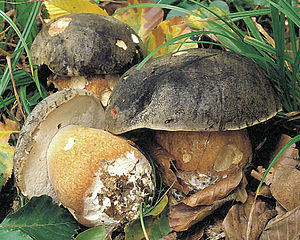Bronze bolete
| Bronze bolete | ||||||||||||
|---|---|---|---|---|---|---|---|---|---|---|---|---|

Bronze boletus ( Boletus aereus ) |
||||||||||||
| Systematics | ||||||||||||
|
||||||||||||
| Scientific name | ||||||||||||
| Boletus aereus | ||||||||||||
| Bull .: Fr. |
The bronze bolete or black-capped boletus ( Boletus aereus ) is a type of mushroom from the family of thick bolete relatives . The edible, but relatively rare, large boletus grows in oak and beech forests that are favored by heat. It was named "Mushroom of the Year 2008" by the German Society for Mycology .
features
The bronze tubular forms large, compact, centrally stalked fruit bodies with hemispherical to cushion-shaped, 6–20 cm, in exceptional cases also up to 25 cm wide hat. The stalk is 5–15 cm long and 2–5 cm thick, thickly bulbous to club-like, rarely cylindrical in age. The top of the hat is coffee, dark to bronze brown, sometimes almost black, often with yellow-brown spots. Particularly young the hat is fine suede-like, in older fruit bodies it becomes bald. The stem is similar in color to the hat, it is only a little pale dark to leather brown and is covered in the upper part by a very fine white to light brown net. The tubes are initially whitish and with increasing age change from cream to green-yellow. The pores are hardly noticeable when young and resemble the tubes in color.
ecology
In Germany, the bronze bolete prefers warm oak-hornbeam mixed forests, oak forests and beech forests, but can occasionally also be found in parks, cemetery complexes and similar biotopes. While most of the finds in the Mediterranean region come from acidic soils, in Central Europe the bronze bolete occurs mostly on neutral and alkaline subsoil. He prefers dry to fresh, loamy locations and avoids wet ground. Like all thick boletus, the bronze bolete is a mycorrhizal producer , although only deciduous trees are considered in Central Europe. There it mainly grows under oaks , much less often with beeches . The fruiting bodies appear in Germany from July to September.
distribution
The species is widespread in Mediterranean to temperate areas in Europe and North America. In North America, the main distribution area is in the south, especially in Florida. In Europe, the bronze bolete occurs in the distribution area of oak and beech. In Germany it is scattered in the south, but rarely found in the north.
Danger
Due to the growth in warm, older oak and beech forests as well as the very scattered occurrence, whereby often only individual fruiting bodies are formed, the bronze bolet is on the warning list in Germany, in Bavaria it is considered endangered. It is under species protection and may not be collected. That is why the species was voted mushroom of the year by the German Society for Mycology in 2008 . This is the second time that a species from the genus of thick boletus has been named mushroom of the year , following Satan's bolete .
literature
- German Josef Krieglsteiner (Eds.), Andreas Gminder , Wulfard Winterhoff: Die Großpilze Baden-Württemberg . Volume 2: Stand mushrooms: inguinal, club, coral and stubble mushrooms, belly mushrooms, boletus and deaf mushrooms. Ulmer, Stuttgart 2000, ISBN 3-8001-3531-0 .
Individual proof
- ↑ Peter Karasch, Christoph Hahn: Red List of Endangered Large Mushrooms in Bavaria . Ed .: Bavarian State Office for the Environment [LfU]. Augsburg 2010 ( lfu.bayern.de [PDF]).
Web links
- German Society for Mycology (DGfM): Boletus aereus Bull .: Fr., Bronze Röhrling. Mushroom of the Year 2008. Retrieved July 13, 2012 .
